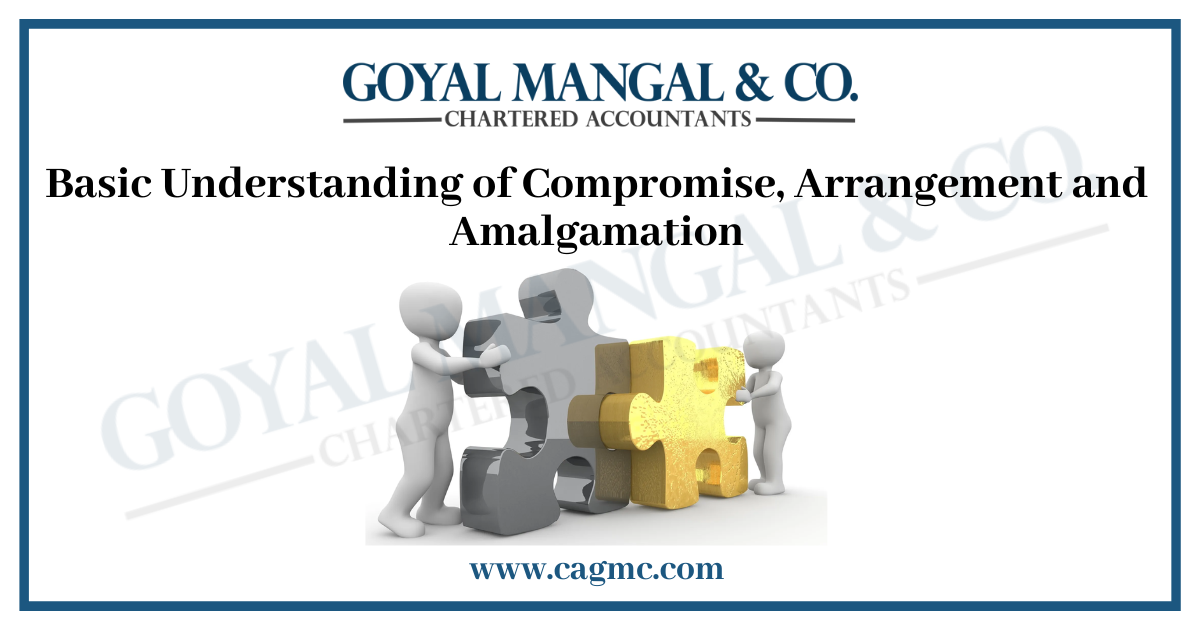
In today’s business world, it is essential to have a clear understanding of legal terms and concepts. The Companies Act, 2013 governs the formation, management, and dissolution of companies in India. Three essential terms under the Companies Act, 2013, are Compromise, Arrangement, and Amalgamation. These terms are crucial for understanding the legal aspects of corporate transactions. In this article we will have a brief look about Compromise, Arrangement, and Amalgamation.
Abstract
With the ever-changing global dynamics and evolution of trade, as well as abundant growth opportunities in global markets, companies are considering collaborating with other companies doing similar or identical business or forming new companies in different locations to be recognized globally and create a brand image.
Mergers and amalgamations are utilized as tools for rapid growth and are rapidly being recognized in India as an important tool in corporate strategy. They are employed in a variety of industries, including information technology, telecommunications, and business process outsourcing, as well as traditional businesses, to increase strength, extend client base, reduce competition, or enter a new market or segment.
What is Compromise?
Compromise refers to an agreement between two or more parties to settle a dispute or a claim. Under the Companies Act, 2013, a compromise refers to an arrangement between a company and its creditors or members or any class of them. The main objective of a compromise is to restructure a company’s debts or share capital without winding up the company.
A company can reorganize or restructure itself partially or completely by internal or external reconstruction. Internal reconstruction includes compromise and arrangement.
As the term compromise is not defined in the Companies Act, 2013 or its rules, it must be interpreted as the resolution of issues by mutual consent or agreement or through a scheme of compromise under sections 230-232 of the Companies Act, 2013.
What is Arrangement?
An Arrangement is similar to a compromise. However, the difference lies in the fact that an arrangement can be between the company and any other person or entity. Under the Companies Act, 2013, an arrangement refers to a reorganization of the company’s share capital or its business or a merger or acquisition of the company with another company or entity.
Arrangement is a kind of Internal reconstruction in which a company-made arrangement in which adjustments are made (inside the company) to the assets/liabilities of the firm to improve the company’s profitability. For example, share capital reduction, share conversion to stock or vice versa, share consolidation, and so on.
So According to Section 230 of the Companies Act, 2013, arrangement comprises reorganizing the company’s share capital through consolidation of distinct classes of shares or division of shares into separate classes of shares, or both.
What is Amalgamation?
Amalgamation is a formal process that unites two or more corporations into one corporation that keeps all the amalgamating corporations’ assets and liabilities. It is a corporate restructuring instrument designed to make combining the businesses of two or more firms as straightforward and efficient as possible.
The amalgamation procedure comprises the transfer of the amalgamating firms’ assets and liabilities to the amalgamated company. The shareholders of the amalgamating companies get shares in the amalgamated company in return for their shares in the amalgamating companies.
What is Merger?
A Merger is a corporate transaction in which two or more existing, independent firms join forces to establish a new, single legal entity. It is a corporate strategy in which multiple companies merge to form a single entity, either to increase their market position or to pursue other strategic goals.
The assets and liabilities of the merging companies are transferred to the new company, and the shareholders of the merging companies receive shares in the new entity in return for their shares in the merging companies.
The properties of the merging companies are retained by the new entity formed by the merger. A merger is a voluntary procedure that can be utilized to achieve a variety of strategic goals, such as cost savings, increased market share, and product diversity.
Benefits of entering an Amalgamation, Compromise and Arrangement
There are various benefits for companies in entering into the amalgamation and mergers:
- For economies of scale.
- To increase the company’s market share.
- To lessen competition.
- To increase the value of shareholders.
- To reduce tax liabilities.
- To create a brand name.
Governing Law for Mergers and Amalgamation
There are several laws regarding compromise, arrangements, and amalgamation which must be investigated before going for the scheme:
- Companies Act, 2013: The Companies Act, 2013 governs the process of mergers, amalgamations, and arrangements.
- National Company Law Tribunal: In India, the National Company Law Tribunal (NCLT) is the regulatory authority that approves merger and amalgamation schemes43. The NCLT verifies that the scheme is in the best interests of the stakeholders and that the procedure is carried out in accordance with the Companies Act, 2013.
- The Competition Act, 2002: The Competition Act, 2002, aims to prevent the abuse of dominant position in the market and protect the interests of smaller businesses
- The Income Tax Act, 1961: The Income Tax Act, 1961 provides tax benefits and advantages to corporations who amalgamate or combine.
- Insolvency and Bankruptcy Code, 2016: The Insolvency and Bankruptcy Code, 2016, consolidates and modifies the laws governing corporate reorganization and insolvency resolution, as well as partnership firms and individuals.
The 2016 Insolvency and Bankruptcy Code establishes a framework for resolving insolvency and bankruptcy matters, particularly those involving mergers and amalgamations.
- Indian Stamp Duty Act, 1899.
- SEBI: The function of SEBI in mergers and amalgamation is to ensure that investors’ interests are protected and that the companies involved follow the necessary legislation and guidelines.
Cross Border Merger
A cross-border merger occurs when two companies from different countries unite. The Foreign Exchange Management (Cross-Border Merger) Regulations, 2018 govern cross-border mergers in India. The regulations set the foundation for inward and outbound mergers, amalgamations, and arrangements between Indian and foreign companies4.
Cross-border mergers require prior approval from the Reserve Bank of India (RBI). The RBI guarantees that the cross-border merger complies with legislation and that stakeholders’ interests are protected.
The requirements also require the enterprises participating in the cross-border merger to value their assets and liabilities. The regulations seek to facilitate and control cross-border mergers while also ensuring that they are conducted in a transparent and efficient manner.
In summary, cross-border mergers in India are governed by the Foreign Exchange Management (Cross-Border Merger) Regulations, 2018, which establish the framework for mergers, amalgamations, and arrangements between Indian and foreign enterprises, including inbound and outbound mergers. The regulations, which require prior RBI clearance, aim to facilitate, and control cross-border mergers.
Fast Track Merger
Section 233 of the Companies Act, 2013 allows for fast-track mergers between two or more small firms or between holding companies and their fully owned subsidiaries without the need for NCLT approval. Fast track mergers, however, are not accessible for cross-border mergers.
Section 230 of Companies Act, 2013: Power to Compromise or make Arrangements with Creditors/Members
The Company can reach an agreement with either its creditor or one of its members.
On the application of a creditor/member/company itself/liquidator (if the company is being wound up), the Tribunal may order a meeting of the creditors/members, which shall be held and conducted in the manner directed by the Tribunal.
All creditors, members, and debenture holders will be notified of the meeting at their respective registered addresses.
- Objections by Members or Creditor: Only a specific group of people can oppose to the compromise or arrangement scheme. Only persons with 10% or more of the company’s share capital OR persons with 5% or more of total o/s debt may object to the scheme of compromise/arrangement.
- Notice to Authorities: According to Section 230(5) of the Companies Act, a notice (along with prescribed documents) shall be sent to the Central Government, Income Tax Authorities, RBI, SEBI, ROC, respective stock exchanges, official liquidator, Competition Commission of India (CCI), if necessary, and such other sectoral regulators/authorities likely to be affected by the compromise or arrangement, and these authorities shall make their representations, if any, within 30 days of receipt of the notice.
If these sectoral regulators/authorities do not make any representations within the above-mentioned time frame, it will be assumed that they have none.
Section 230(6) of the Companies Act, 2013
Dual majority refers to two conditions that must be met before the Tribunal can issue a compromise/arrangement order. The two conditions are as follows:
- A simple majority of those voting must be verified. (That is, more than half of those voting in the meeting must support the compromise/arrangement.)
- The scheme must be approved by at least 3/4 of the creditors/members.
- If both conditions are met, the Tribunal will issue a decision in favour of the scheme, which will be binding on the firm, its members/creditors, liquidators, and contributors.
Section 232 of Companies Act, 2013: Merger & Amalgamation of Companies
Section 232 of the Companies Act, 2013 states that when an application is filed to the Tribunal under Section 230 for the merger or amalgamation of two or more companies, and that under this plan, the entire or any part of the business, property, or liability is to be transferred,
The Tribunal may then call a meeting of such creditors or members. Notice must be made in the manner specified in Sections 230(3) to 230(6).
Transfer of assets/liabilities will occur as soon as the Tribunal issues an order. A certified copy of the order must be filed with the ROC within 30 days of receipt or order. In addition, a legally certified statement of scheme compliance must be filed with the ROC.
Section 237 of Companies Act, 2013: Power of Central Government to provide for Amalgamation of Companies in Public Interest
Where the Central Government is convinced that it is necessary in the public interest for two or more companies to amalgamate, the Central Government will notify the same by order in the Official Gazette and provide for amalgamation into a single company.
The order may state that the transferor company’s legal procedures against the transferee corporation may continue.
Before amalgamation, every member/creditor of each transferor business shall have, as closely as feasible, the identical rights/interests in the transferee company. If their rights/interests are less, they are entitled to compensation.
Conclusion
In conclusion, compromise, arrangement, and amalgamation are legal terms that play a crucial role in the restructuring of a company’s affairs. Companies can use these processes to resolve financial difficulties, restructure capital, debts, or shares, and merge or acquire other companies to expand their business. It is important to understand the basic concepts of these legal terms to make informed decisions about a company’s restructuring.


